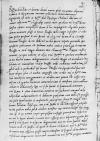Significata est mihi a reverendissimo domino ⌊episcopo Chelmensi⌋ domino meo et amico observandissimo et ab aliis amicis meis quaedam Vestrae Dominationis Reverendissimae de me sinistra opinio, nempe quod superinscribed⌈quodquod superinscribed⌉ Vestrae Reverendissimae Dominationi hoc impingerem idque mihi persuaderem neminem fuisse in terris ⌊Prussiae⌋ mihi magis infensum et odiosum praeter personam Dominationis Vestrae Reverendissimae ob id, quod Vestra Reverendissima Dominatio in ⌊comitiis terrarum Prussiae⌋ de me deberet verba facere, utpote, quomodo ipse existens extraneus et Diboviae natus, contra privilegia terrarum Prussiae a ⌊maiestate regia⌋ domino meo clementissimo in Prussia castra teneam. Ex qua ratione et aliis Vestra Reverendissima Dominatio quodam malevolo in me ducta animo indignationem ⌊maiestatis regiae⌋ et invidiam nobilitatis et civitatum ⌊terrarum Prussiae⌋ mihi ordinare moliretur (id, quod ut mihi a quibusdam ex terris Prussiae ita significatum fuerat, brevi aliquo felici et mutuo congressu cum verbis Vestrae Dominationis Reverendissimae tum litteris innotescere non gravarer. Et abdita non pauca illi referrem, nisi me id, quod inter homines amarulentias et intestina odia nollem inducere, abduceret). Quae res si sic fuerit et huiusmodi animum Vestra Reverendissima Dominatio citra demeritum meum in me habuerit, magnam mihi afferebat admirationem et dolorem, praesertim cum mihi sit perspecta satis familiaritas et consuetudo ⌊parentis mei⌋ carissimi, magnifici olim domini palatini Posn(aniensi), quae cum Vestra Reverendissima Dominatio illi intercesserat, utpote tanta, qualem nulla potest abolere vetustas. Nec minus mihi ipsi hoc semper curae est et ex animo cupio, quo possim vestigiis ⌊parentis mei⌋ inhaerere ac Vestrae Dominationi Reverendissimae, domino et amico meo, officiis meis inserviens gratus fore. Quod si Vestra Reverendissima Dominatio abicere dignaretur, non me bene habuit. Nihil tamen mali et sinistri id, quod et decori et honori Vestrae Dominationis Reverendissimae, domino et amico meo, officere possit imprecatus sum, et si quid obtrectatores et scelerati aliqui in me reiecerint, conabor me Vestrae Reverendissimae Dominationi purgare canonice
 BK, 230, p. 90
ita, ut omnem, quem si quando animum in me acuerit, in delatores retorquebit. Et propterea non ita pridem scripseram litteras meas accersendo ad me dominum ⌊Nicolaum Plotowski⌋ magistrum curiae Dominationis Vestrae Reverendissimae cumque id, quod verbis egi in hac re, illi procul dubio rettulit. Quamvis itaque Vestram Reverendissimam Dominaitonem ex me ipse numquam offenderim et tutam conscientiam mihi esse cognoverim, recordatus tamen veteris consuetudinis Reverendissimae Dominationis Vestrae cum domo mea et meipso necnon verborum ⌊Salvatoris⌋ nostri: cf. Vulg. Ps (G) 54:13 Quoniam si inimicus maledixisset mihi, sustinuissem utique, et si is, qui oderat me, super me magna locutus fuisset, abscondissem me forsitan ab eo. ⌊Si inimicus meus etc.cf. Vulg. Ps (G) 54:13 Quoniam si inimicus maledixisset mihi, sustinuissem utique, et si is, qui oderat me, super me magna locutus fuisset, abscondissem me forsitan ab eo. ⌋, ut iunior a Vestra Reverendissima Dominatione maiore meo primus precor veniam obnixe ac studiose rogando, velit eximie Vestra Reverendissima Dominatio me prosequi favore et gratia sua. In qua re et officium et iurata ⌊terrae Prussiae⌋ Vestrae Reverendissimae Dominationis fides, cum ipse ex progenitoribus et una cum filiis meis Prutenis sim, inviolata et non vitiata manebit. Et ipse cum id intellexerim, experiet me vicissim Vestra Reverendissima Dominatio personae domini et omnibus suis, quibus mandaverit fidum et sincerum amicum ac servitorem cum tota familia mea ad quaevis obeunda obsequia una cum vita et rebus meis semper pronum et paratissimum. Cuius gratiae et favori iterum me commendo, cupiens Vestram Reverendissimam Dominationem frui optima diutissimaque valetudine et felicia quaeque ex animo illi obtigisse.
BK, 230, p. 90
ita, ut omnem, quem si quando animum in me acuerit, in delatores retorquebit. Et propterea non ita pridem scripseram litteras meas accersendo ad me dominum ⌊Nicolaum Plotowski⌋ magistrum curiae Dominationis Vestrae Reverendissimae cumque id, quod verbis egi in hac re, illi procul dubio rettulit. Quamvis itaque Vestram Reverendissimam Dominaitonem ex me ipse numquam offenderim et tutam conscientiam mihi esse cognoverim, recordatus tamen veteris consuetudinis Reverendissimae Dominationis Vestrae cum domo mea et meipso necnon verborum ⌊Salvatoris⌋ nostri: cf. Vulg. Ps (G) 54:13 Quoniam si inimicus maledixisset mihi, sustinuissem utique, et si is, qui oderat me, super me magna locutus fuisset, abscondissem me forsitan ab eo. ⌊Si inimicus meus etc.cf. Vulg. Ps (G) 54:13 Quoniam si inimicus maledixisset mihi, sustinuissem utique, et si is, qui oderat me, super me magna locutus fuisset, abscondissem me forsitan ab eo. ⌋, ut iunior a Vestra Reverendissima Dominatione maiore meo primus precor veniam obnixe ac studiose rogando, velit eximie Vestra Reverendissima Dominatio me prosequi favore et gratia sua. In qua re et officium et iurata ⌊terrae Prussiae⌋ Vestrae Reverendissimae Dominationis fides, cum ipse ex progenitoribus et una cum filiis meis Prutenis sim, inviolata et non vitiata manebit. Et ipse cum id intellexerim, experiet me vicissim Vestra Reverendissima Dominatio personae domini et omnibus suis, quibus mandaverit fidum et sincerum amicum ac servitorem cum tota familia mea ad quaevis obeunda obsequia una cum vita et rebus meis semper pronum et paratissimum. Cuius gratiae et favori iterum me commendo, cupiens Vestram Reverendissimam Dominationem frui optima diutissimaque valetudine et felicia quaeque ex animo illi obtigisse.
 BK, 230, p. 90
ita, ut omnem, quem si quando animum in me acuerit, in delatores retorquebit. Et propterea non ita pridem scripseram litteras meas accersendo ad me dominum
BK, 230, p. 90
ita, ut omnem, quem si quando animum in me acuerit, in delatores retorquebit. Et propterea non ita pridem scripseram litteras meas accersendo ad me dominum 

